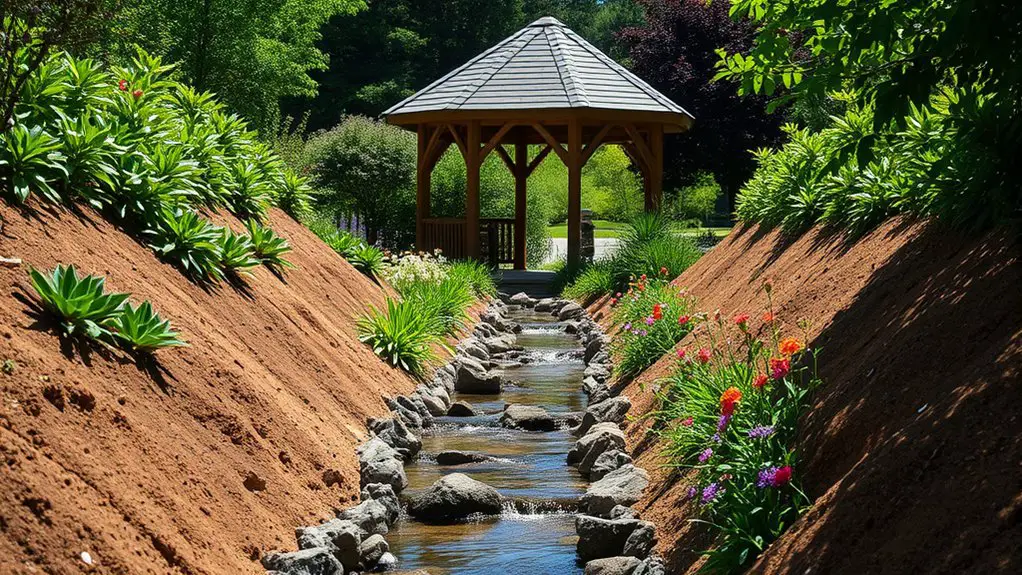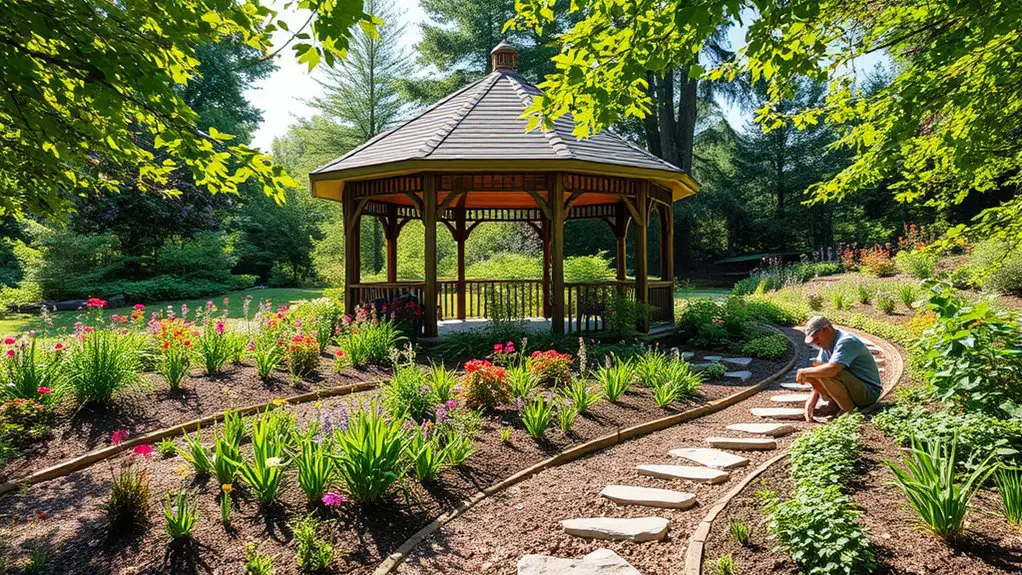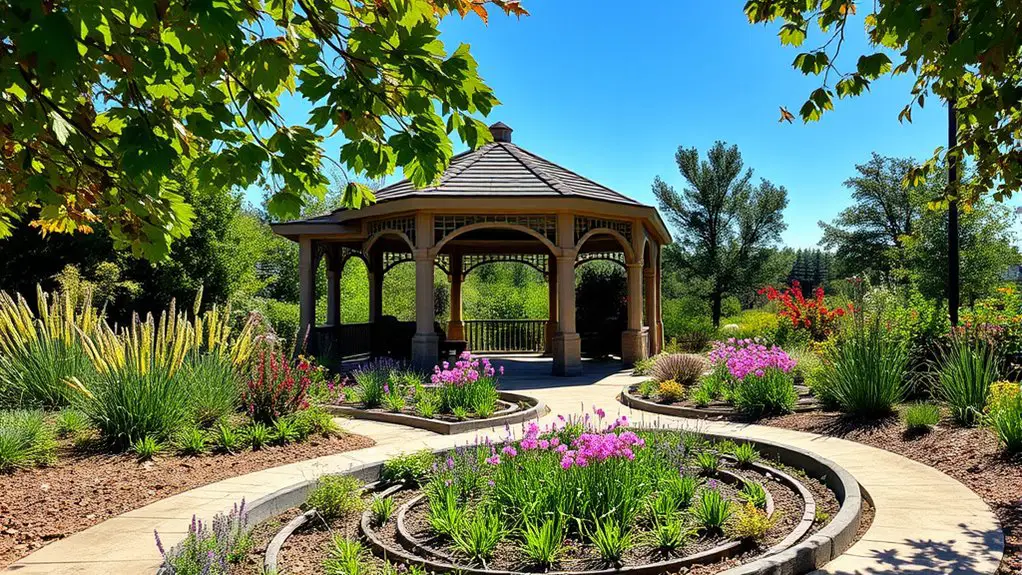To incorporate rain gardens and swales around your gazebo, start by evaluating your site’s drainage and soil type. Position swales to direct excess water away from structures, while using rain gardens to capture runoff. Choose native, drought-tolerant plants for their deep roots and low maintenance. Layer these plants for visual interest and improved stormwater management. With the right planning and design, you’ll create a sustainable oasis. There’s plenty more to explore about enhancing your outdoor space.
Understanding Rain Gardens and Swales

When you think about enhancing your landscape around a gazebo, understanding rain gardens and swales is essential. Rain gardens are designed to capture and manage runoff, promoting groundwater recharge while filtering pollutants. Their benefits include creating a vibrant habitat for local wildlife and reducing erosion, making your outdoor space both beautiful and eco-friendly.
Swales, on the other hand, are shallow, vegetated channels that facilitate water drainage and infiltration. They function to direct excess water away from your gazebo, preventing pooling and potential damage. By integrating swales into your landscape, you not only manage water effectively but also enhance the aesthetic appeal with lush vegetation.
Together, rain gardens and swales create a harmonious, sustainable environment that celebrates nature while granting you the freedom to enjoy your outdoor oasis without worry. Embracing these features fosters resilience in your landscape, ensuring it thrives even amidst changing weather patterns.
Planning Your Outdoor Space
Creating an inviting outdoor space around your gazebo requires thoughtful planning that balances aesthetics, functionality, and sustainability. Start by envisioning the overall outdoor design; consider how you want to utilize the space for gatherings, relaxation, and connection with nature. Functional landscaping is key; you’ll want to incorporate elements like rain gardens and swales that not only enhance beauty but also manage water efficiently.
Map out the area, ensuring pathways are accessible and inviting. Position your gazebo to maximize views and sunlight while providing shelter. Think about how the elements interact—like the way rain gardens can filter stormwater runoff while attracting pollinators.
Choosing the Right Plants

How do you choose the right plants for your rain gardens and swales? Start by considering native plants, as they offer numerous benefits. Native species are adapted to your local climate, ensuring they thrive without excessive care. Their deep roots improve soil structure and enhance water absorption, which is essential for managing runoff around your gazebo.
Look for plants with drought tolerance; these resilient species will survive dry spells, minimizing the need for supplemental watering. Grasses, wildflowers, and shrubs that naturally occur in your region will not only beautify your space but also support local wildlife, fostering biodiversity.
When selecting, think about layering your plants to create visual interest and maximize functionality. Choose a mix of heights and textures to enhance the aesthetic appeal while ensuring effective stormwater management. By thoughtfully selecting plants, you’ll cultivate an eco-friendly oasis that harmonizes with nature and celebrates your desire for freedom.
Designing Your Rain Garden and Swale Layout
When designing your rain garden and swale layout, it’s essential to assess site conditions first, as this will guide your plant selection strategies. Consider factors like soil type, sunlight, and drainage to guarantee your garden thrives. With the right planning, you’ll create a sustainable landscape that not only enhances your gazebo but also supports local ecosystems.
Assessing Site Conditions
Before you plunge into designing your rain garden and swale layout, it’s essential to assess the site conditions, as they play a crucial role in the success of your project. Start by evaluating site drainage; observe how water flows and collects during storms. This’ll help you determine the best locations for your rain garden and swales. Next, test the soil types in your area—whether clay, sandy, or loamy—as they influence water absorption and plant health. Knowing your soil’s infiltration rate will guide you in sizing your rain garden correctly. By understanding these conditions, you’ll harness the natural landscape to create a functional and sustainable oasis around your gazebo, allowing you to enjoy the beauty of nature without compromising environmental integrity.
Plant Selection Strategies
Choosing the right plants for your rain garden and swales is vital, as they not only enhance the aesthetic appeal but also play an important role in managing stormwater effectively. Prioritize native plants, as they’re adapted to local climates and promote biodiversity. Look for species with drought tolerance to guarantee resilience during dry spells.
Here’s a helpful table to guide your selections:
| Plant Type | Drought Tolerance |
|---|---|
| Blue Flag Iris | Moderate |
| Swamp Milkweed | High |
| Black-Eyed Susan | Moderate |
| Butterfly Weed | High |
| Joe Pye Weed | Moderate |
Maintenance Tips for Sustainability

While maintaining the beauty and functionality of rain gardens and swales surrounding your gazebo, it is essential to adopt a sustainable approach that minimizes environmental impact. Start with effective rainwater management; make sure your swales are clear of debris, allowing efficient water flow. Regularly check for erosion and address it promptly to maintain soil health and prevent sediment loss.
Incorporate native plants, as they require less maintenance and enhance biodiversity. Mulching can help retain moisture, reduce weeds, and improve soil structure. When you prune or remove plants, compost the organic matter to enrich the soil naturally.
Don’t forget to monitor drainage patterns, adjusting as necessary to prevent pooling. Finally, consider seasonal maintenance schedules to keep your rain gardens thriving year-round. By following these tips, you’ll not only enhance the sustainability of your space but also create a serene environment to enjoy around your gazebo.
Enhancing Aesthetics Around Your Gazebo
To enhance the aesthetics around your gazebo, consider integrating elements that harmonize with the natural landscape while promoting sustainability. Start by selecting gazebo decor that reflects your style—think rustic wooden benches or vibrant cushions made from eco-friendly materials. Surround your gazebo with native plants to create a seamless shift between built and natural environments.
Incorporate rain gardens and swales, which not only manage stormwater but also add beauty and functionality. Use these features to define pathways, ensuring they guide visitors naturally to your gazebo. Consider adding decorative stones or mulch that complement your plant choices, fostering landscape harmony. Additionally, incorporating a gazebo can increase property value and create a desirable outdoor feature for family and friends to enjoy.
Lighting can also play an essential role; soft, solar-powered lights can illuminate pathways and highlight features without harming the environment. By thoughtfully combining these elements, you’ll create an enchanting space that invites relaxation and connection with nature.
Frequently Asked Questions
What Is the Cost of Installing Rain Gardens and Swales?
When considering installation costs for rain gardens and swales, you’ll find initial expenses can vary widely. Don’t forget to account for ongoing maintenance expenses, which can guarantee these sustainable solutions thrive over time.
How Can I Ensure Proper Drainage in Heavy Rain?
Imagine a sponge soaking up water; that’s how effective drainage solutions work during heavy rainfall. Guarantee your site’s graded correctly, use permeable materials, and consider incorporating swales to guide excess water away sustainably.
Are There Local Regulations for Rain Garden Installations?
You’ll want to check local permits and installation guidelines before starting your rain garden. Ensuring compliance not only fosters environmental sustainability but also grants you the freedom to create a thriving, eco-friendly landscape.
Can I Install Rain Gardens and Swales Myself?
Yes, you can tackle DIY installation of rain gardens and swales. Not only do they enhance your landscape, but they also provide ecological benefits, like improved drainage and habitat for wildlife, fostering a sustainable environment.
What Tools Do I Need for Maintenance?
For effective maintenance, you’ll need essential maintenance tools like pruning shears, trowels, and rakes, along with gardening supplies such as mulch and compost. These will help you nurture your rain gardens and swales sustainably, ensuring vibrant growth.

